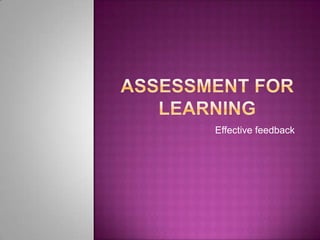
Effective feedback
- 2. If our aim is to improve student performance, not just measure it, we must ensure that students know the performances expected of them, the standards against which they will be judged, and have opportunities to learn from the assessment in future assessments. (Grant Wiggins, 2002)
- 3. Feedback is information about how we have performed in relation to a stated goal. Feedback tells us what did or did not happen:
- 4. Effective feedback provides: information about what happened or was done an evaluation of how well or otherwise the action or task was performed guidance as to how performance can be improved.
- 5. Is specific and avoids vague comments. Is varied in its method of application. Uses models showing desired outcomes.
- 6. Shows a valuing of student work. Uses marks or grades only some of the time. Provides time for students to act upon advice. Enables students to know how they will benefit.
- 7. Feedback can occur at any point in the learning cycle: – while students are working on a task – while students are presenting a task – at the end of the task.
- 8. Acknowledges success and provides an indication in several areas where improvement could occur. Is accessible – must be able to be read and understood. Students are made aware of the purposes of feedback.
- 9. A whole-school policy? Communicate clearly to both students and parents how feedback on learning will be provided. Clarify with parents the feedback strategies to be used.
- 10. Teacher comments should focus on improvement in future tasks. „Comments like “Use paragraphs!” are useless – if I knew how to use them, I would have done so.‟ „I could do better if I was told exactly what I could do better.‟
- 11. Effective comments are clear, brief and related to the specific learning intention. Some research indicates that too much praise can negatively impact on boys and more able students.
- 12. Thereis no one appropriate way of providing feedback to students. Rather, the nature of the task and the context of the work in the particular learning area should determine the form in which the feedback occurs.
- 13. In some learning areas, moderate and focused praise is essential in building student self-confidence. Inother areas, students need to focus on the processes not just the outcomes.
- 14. Ticking of correct answers can be counter- productive. Peer correction and periodic teacher checks could be more effective: – peer assessment/feedback needs practice and teacher guidance – peer assessment/feedback helps make students more reflective of their own work.
- 15. Some learning areas require ongoing and regular student-teacher dialogue, with feedback to guide students through smaller key developmental steps. In other learning areas, keeping the balance between feedback about content or knowledge and feedback about process is crucial as feedback often needs to correct key misunderstandings.
- 16. Verbal feedback should encourage higher order thinking of a more open-ended kind. Use of a positive tone of voice, with regular indications that the teacher is listening, enables the students to feel at ease and to be willing to actively participate in the dialogue. Avoid damaging self-esteem – concentrate on the task rather than the student.
- 17. Work with students to ensure understanding of the meaning and application of assessment criteria prior to their commencement of a task. Use wall displays and checklists which identify what is being sought in the learning.
- 18. Give verbal feedback while students work on a task. Model the standard of work required and frame feedback in relation to this. Ask students to maintain learning journals.
- 19. Use self-adhesive notes to give quick feedback, without devaluing the student‟s work, especially in the case of major projects. Encourage students to write a learning intention at the outset.
- 20. Consciously focus on highlighting successes. Use marks or grades sparingly, not constantly. Make use of student self-assessment or peer assessment.
